Scientific Papers in SCI
2020
2020
Química de Superficies y Catálisis
Effect of Gold Particles Size over Au/C Catalyst Selectivity in HMF Oxidation Reaction
Megias-Sayago, C; Lolli, A; Bonincontro, D; Penkova, A; Albonetti, S; Cavani, F; Odriozola, JA; Ivanova, SChemcatchem, 12 (2020) 1177-1183 DOI: 10.1002/cctc.201901742
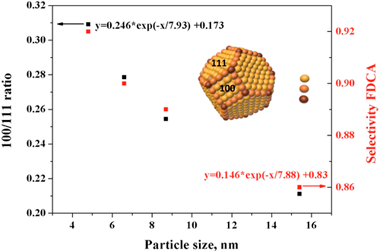
Abstract
A series of gold nanoparticles in the 4-40 nm range were prepared, immobilized on activated carbon and further tested, at low base concentration, in the catalytic oxidation of 5-hydroxymethyl furfural (HMF) to 2,5-furandicarboxylic acid (FDCA). Gold particles size variation has no influence on HMF conversion but significantly affects product selectivity and carbon balance. This behavior is ascribed to the thermodynamically favorable oxygen reduction reaction on Au(100) faces. As the gold particle size decreases the Au(100)/Au(111) exposure ratio, estimated by using the van Hardeveld-Hartog model, increases as well as the FDCA selectivity. The smaller the gold particle size the smaller the 5-hydroxymethyl-2-furancarboxylic acid (HMFCA) to FDCA ratio pointing to the gold size dependent behavior of the oxidation of the alcohol function of the HMF molecule.
February, 2020 · DOI: 10.1002/cctc.201901742
Materiales Ópticos Multifuncionales
Mesoporous Matrices as Hosts for Metal Halide Perovskite Nanocrystals
Rubino, A; Calio, L; Garcia-Bennett, A; Calvo, ME; Miguez, HAdvanced Optical Materials, (2020) 201901868 DOI: 10.1002/adom.201901868
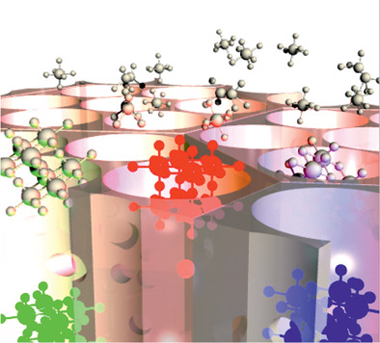
Abstract
Several works have recently demonstrated that perovskite nanocrystals can be controllably formed within a variety of porous matrices employing diverse synthetic strategies. By means of the fine tuning of the pore size distribution, the thickness and composition of the walls, the geometry of the void network and its topology, strict control over the structural and morphological parameters of the hosted semiconductor can be achieved, determining its optical absorption and emission properties. Furthermore, porous hosts provide the guest semiconductor with enhanced stability and versatility in terms of processing, which favors its integration in devices. This article provides a comprehensive review of the different approaches proposed, as well as a discussion on the relevance they may have for the development of nanostructured perovskite-based optoelectronics. A critical assessment of the optical quality of the hybrid perovskite nanomaterials so obtained is presented, as well as an analysis of the fundamental and applied aspects of the nanocrystal-matrix interaction and a projected prospect of their impact in the fields of artificial lighting and renewable energy.
February, 2020 · DOI: 10.1002/adom.201901868
Fotocatálisis Heterogénea: Aplicaciones
Evaluation of Au–ZnO, ZnO/Ag2CO3 and Ag–TiO2 as Photocatalyst for Wastewater Treatment
Murcia, J.J.; Hernández, J.S.;Rojas, H.; Moreno-Cascante, J.; Sánchez-Cid, P.; Hidalgo, M.C.; Navío, J.A.; Jaramillo-Páez, C.Topics in Catalysis, (2020) DOI: 10.1007/s11244-020-01232-z
Abstract
In this work series of photocatalysts based on ZnO modified by Au and Ag2CO3 addition and Ag–TiO2 materials were synthesized and evaluated in the treatment of handicrafts factories wastewater and water samples taken from a highly polluted river. In general, it was found that ZnO series were more effective in the bacteria elimination than the commonly used TiO2 semiconductor. It was also observed that the metal (Au, Ag) or silver carbonate addition significantly increases the photocatalytic activity of ZnO and TiO2. It was determined that the content of the metal or carbonate added is an important factor to take into account in order to obtain suitable efficiency in the photocatalytic process, so, for example in the case of the river water samples the increase of Ag2CO3 content from 1 to 5%, had a detrimental effect over the bacteria elimination. The optimal conditions for dyes photodegradation and bacteria elimination were found by using a response surface study and the Au–ZnO (1%) photocatalyst. From this study it was determined that even after recycling this material leads to obtain a removal percentage of these pollutants over than 94%.
February, 2020 · DOI: 10.1007/s11244-020-01232-z
Fotocatálisis Heterogénea: Aplicaciones
Hybrid ZnO/Ag3PO4 photocatalysts, with low and high phosphate molar percentages
Martín-Gómez, A.N.;Navío, J.A.;Jaramillo-Páeza, C.;Sánchez-Cid, P.;Hidalgo, M.C.Journal of Photochemistry and Photobiology A: Chemistry, (2020) 112196 DOI: 10.1016/j.jphotochem.2019.112196

Abstract
In this work, a previously optimized synthesized ZnO photocatalyst was modified with different molar percentages of Ag3PO4 through a facile in situ precipitation–deposition method and then characterized by different techniques (XRD, XRF, BET, UV–vis DRS, SEM, TEM and XPS). The incorporation of Ag3PO4 produces important changes in the light absorption properties with a significant absorbance in the visible region observed for ZnO modified with different amounts of Ag3PO4; the optical absorption intensity in the visible region of the coupled ZnO/Ag3PO4 increases as the molar percentages of Ag3PO4 increases, evidencing a clear dependence on the content of Ag3PO4. However, this work shows that the incorporation of Ag3PO4 in almost all cases reduces the photocatalytic capacity of ZnO, except when it is used in a specific percentage of 10 % and only being more active against rhodamine B and not on the Caffeine. SEM images and elemental mapping indicate that Ag3PO4 disperses very well in the ZnO particles, exhibiting an almost homogeneous distribution, showing zones with cumulus of Ag3PO4 (rich in P-Ag) in contact with ZnO-zones (rich in Zn). All the prepared photocatalysts were tested in the photocatalytic degradation of rhodamine B as a dye, and caffeine as a toxic and persistent emerging compound under UV and visible light illumination. It is reported that not only the ZnO:Ag3PO4 ratio is an important factor that influences the photocatalytic process of substrate degradation, but also the nature of the substrate has an important influence on the photocatalytic behavior of the materials under both UV and visible illumination. Thus, pristine Ag3PO4 showed high photocatalytic degradation for rhodamine B, while for caffeine negligible photocatalytic degradation was found in both the UV and visible regions. The thermal- and photo-stability of the coupled system was also studied. At least, for rhodamine B no loss of photocatalytic activity has been observed after five recycles although the mineralization degree progressively diminished along the recycles.
February, 2020 · DOI: 10.1016/j.jphotochem.2019.112196
Química de Superficies y Catálisis
Modulation of the acidity of a vermiculite and its potential use as a catalytic support
Amaya, J; Bobadilla, L; Azancot, L; Centeno, M; Moreno, S; Molina, RJournal of Materials Science, 55 (2020) 6482-6501 DOI: 10.1007/s10853-020-04445-5
Abstract
The modulation and characterization of the acidity of a vermiculite were carried out, which was modified by delamination by means of hydrothermal and acid treatments with the subsequent incorporation of AlZr and AlCe species to modulate the acidity. The effect of these species was evaluated regarding the structural (XRD, XPS and IR), textural (N-2 sortometry) and acidity properties (NH3-TPD, NH3-DRIFTS and CO adsorption at low temperature). The catalytic performance was studied in the dehydration-dehydrogenation reactions of 2-propanol and the hydroconversion of decane, which generate important information about the acidity properties such as the type, number and strength of acidic sites. The correlation between the number, type and acid strength with the catalytic behavior allowed to establish the important effect regarding the nature of the mineral, its method of delamination and the nature of the incorporated cation, thus generating tools for controlled processes for the potentiation of the acidity of new supports from raw vermiculite.
February, 2020 · DOI: 10.1007/s10853-020-04445-5
Nanotecnología en Superficies y Plasma
Robust label-free CuxCoyOz electrochemical sensors for hexose detection during fermentation process monitoring
Lopez-Fernandez, E; Gil-Rostra, J; Espinos, JP; Gonzalez, R; Yubero, F; de Lucas-Consuegra, A; Gonzalez-Elipe, ARSensors and Actuators B-Chemical, 304 (2020) 127360 DOI: 10.1016/j.snb.2019.127360

Abstract
Label free electrochemical sensors of glucose are used whenever long-term operation and stable response are required. For this purpose, various metals and oxides of the first transition series have been proposed as alternative to more expensive noble metal electrochemical sensors. In this work we propose a new formulation consisting of copper-cobalt mixed oxides which, in the form of porous and nanostructured thin films with well controlled Co/Cu ratio, are prepared at room temperature in one step by a modification of the magnetron sputtering oblique angle deposition procedure. Films with various compositions were electrochemically characterized by cyclic voltammetry to determine their amperometric response to glucose as a function of voltage and NaOH electrolyte concentration. This analysis showed that films with a Co/Cu atomic ratio equal 3.4 presented a maximum sensitivity (0.710 A M−1 cm−2), a small limit of detection (0.105 μM) and a resilient behaviour upon cycling operation and long storage periods that clearly overpassed the performance of copper and cobalt single oxides. The CuxCoyO electrocatalysts also presented a good selectivity towards glucose and fructose in the presence of common interference compounds found in biological fluids (e.g., ascorbic acid, acetaminophen and uric acid), sucrose and ethanol, this latter present in many agrofood liquids. The possibilities of this sensor electrocatalyst have been tested for the analysis of a wine synthetic fermentation process. The comparison of the electrochemical results with conventional analytical methods showed a lineal amperometric response with respect hexose contents in a must at different stages of its transformation into wine.
February, 2020 · DOI: 10.1016/j.snb.2019.127360
Química de Superficies y Catálisis
Recent advances in selective oxidation of biomass-derived platform chemicals over gold catalysts
Megias-Sayago, C; Navarro-Jaen, S; Castillo, R; Ivanova, SCurrent Opinion in Green and Sustainable Chemistry, 21 (2020) 50-55 DOI: 10.1016/j.cogsc.2019.12.001

Abstract
Gold is without a doubt the best known metal for chemical oxidation. The noblest of the noble metals gained its place because of its resistance to overoxidation, low temperature of operation, especially in gas-phase oxidation, and fairly good selectivity when required. The aim for sustainable development and the need for new technologies open the possibility to introduce new raw materials and new catalyst formulation. That is why new horizons appear in the otherwise uncertain future of gold catalysis. The old glory becomes now a glorious alternative, and this mini-review gives only a small example of it.
February, 2020 · DOI: 10.1016/j.cogsc.2019.12.001
Fotocatálisis Heterogénea: Aplicaciones
Role of Fe(III) in aqueous solution or deposited on ZnO surface in the photoassisted degradation of rhodamine B and caffeine
Tanji, Karim; Navio, J A; Martin-Gomez, A N; Hidalgo, M C; Jaramillo-Paez, C; Naja, Jamal; Hassoune, Hicham; Kherbeche, AbdelhakChemosphere, 241 (2020) 125009 DOI: 10.1016/j.chemosphere.2019.125009
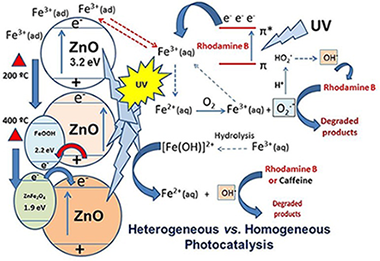
Abstract
Iron (III) was incorporated, to the surface of a synthesized ZnO, using two nominal molar percentages of Fe (III): 1% and 5% Fe relative to ZnO. Samples dried and calcined at 200 °C and 400 °C for 2 h, were characterized by XRD, XPS, XRF, N2-adsorption-BET and (UV–vis)-DRS. Photocatalytic activities of the catalysts were assessed based on the degradation of rhodamine B (RhB) and caffeine (CAF) in aqueous solution under two irradiation conditions: UV and visible light illumination. Prior to the photocatalytic tests, the interaction of each one of the substrates with either Fe(III) or Fe(II) was studied in homogeneous medium under UV-illumination and oxygenated environment. It was found that Fe (III) can play an important role in homogeneous media in the photoassisted degradation, both of rhodamine B and caffeine, while Fe (II) does not exert a relevant role in the photoassisted degradation of the referred substrates. Fe–ZnO samples display similar or poorer performance than pure ZnO in the presence of UV light for both studied substrates. The phenomenon can be attributed to the formation of either goethite or ZnFe2O4 at the ZnO surface where the coupled Fe3+/Fe2+ can act as recombination centers for the photogenerated charges. On the contrary, all Fe–ZnO samples showed enhanced photocatalytic activity under visible illumination which seems to be independent of the iron content. In this context, the mechanisms for photoassisted degradation of both the substrates in homogeneous medium and photocatalytic degradation are discussed, as well as the role of Fe in the photodegradation processes.
February, 2020 · DOI: 10.1016/j.chemosphere.2019.125009
Química de Superficies y Catálisis
Monolithic stirrer reactor: The selective lactose oxidation in liquid phase over Au/Al2O3 nanostructured catalysts
Regenhardt, SA; Meyer, CI; Sanz, O; Sebastian, V; Ivanova, S; Centeno, MA; Odriozola, JA; Montes, M; Marchi, AJ; Garetto, TFMolecular Catalysis, 481 (2020) 110219 DOI: 10.1016/j.mcat.2018.10.014
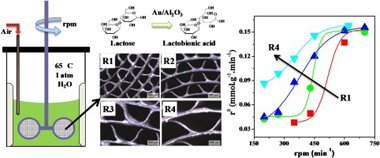
Abstract
The performance of rotating metallic monolith stirrer reactor was studied for selective lactose oxidation in liquid phase at 65 degrees C, atmospheric pressure and with air as oxidant agent. The Au/Al(2)O(3)deposition on metallic substrates was performed by wash-coating, producing catalyst coating thicknesses between 5 and 20 mu m. Monoliths with different configuration (channel size between 0.36 and 1.06 mm) were used as stirrer blades in a batch reactor. Internal and external mass transfer limitations were observed during liquid phase lactose oxidation. For stirring rates equal or higher than 600 rpm there were no important external diffusional restrictions and this was also independent of the monolith configuration. Coating with thickness higher than 15 mu m presents loss of catalyst effectiveness due to internal diffusional restrictions. Excellent stability in the catalytic tests was obtained after three regeneration-reaction cycles. Regeneration was carried out at 400 degrees C in air flow. Gold particle size distribution in the monolith washcoat, determined by TEM before and after reaction, was homogeneous with a medium size of around 5 nm. This is in agreement with the very good reproducibility and stability obtained in the catalytic tests. After calcination at 500 degrees C, some sintering and a heterogeneous distribution of metal particle size was observed, accompanied by a slight loss in catalyst activity. It is concluded that metallic monolith stirrer reactors are a promising application for selective lactose oxidation in liquid phase.
February, 2020 · DOI: 10.1016/j.mcat.2018.10.014
Reactividad de Sólidos
Synthesis of Mn2+-doped ZnS by a mechanically induced self-sustaining reaction
Aviles, MA; Cordoba, JM; Sayagues, MJ; Gotor, FJJournal of Materials Science, 55 (2020) 1603-1613 DOI: 10.1007/s10853-019-04138-8
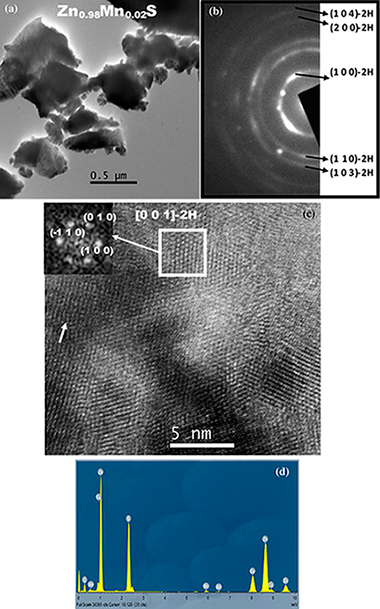
Abstract
The mechanochemical process denoted as a mechanically induced self-sustaining reaction was successfully applied in obtaining Mn-doped ZnS samples with Mn content between 0 and 5 mol%. The process consists in milling Zn/Mn/S powder elemental mixtures with the appropriate stoichiometry, which promotes after approximately 80 min the induction of a combustion reaction. The doping level was properly adjusted by controlling the atomic ratio of the starting mixture. A complete characterization of samples was carried out, including X-ray diffraction, high-resolution transmission electron microscopy, selected area electron diffraction, energy-dispersive X-ray spectroscopy, Raman spectroscopy, diffuse reflectance UV-Vis spectroscopy and emission and excitation photoluminescence measurements. A wurtzite structure, in which Mn2+ replaces Zn2+, was obtained with a nanometric character. The photoluminescence of samples showed the characteristic (Mn2+T1)-T-4-(6)A(1) emission that was highly dependent on the doping level. The maximum luminescence efficiency through the ZnS excitation was found for a doping value of 1 mol%. The photoluminescence showed virtually no contribution from the host emission, which confirmed that samples were properly doped.
February, 2020 · DOI: 10.1007/s10853-019-04138-8
Química de Superficies y Catálisis
Catalytic Performance of Bulk and Al2O3-Supported Molybdenum Oxide for the Production of Biodiesel from Oil with High Free Fatty Acids Content
Navajas, A; Reyero, I; Jimenez-Barrera, E; Romero-Sarria, F; Llorca, J; Gandia, LMCatalysts, 10 (2020) 158 DOI: 10.3390/catal10020158
Abstract
Non-edible vegetable oils are characterized by high contents of free fatty acids (FFAs) that prevent from using the conventional basic catalysts for the production of biodiesel. In this work, solid acid catalysts are used for the simultaneous esterification and transesterification with methanol of the FFAs and triglycerides contained in sunflower oil acidified with oleic acid. Molybdenum oxide (MoO3), which has been seldom considered as a catalyst for the production of biodiesel, was used in bulk and alumina-supported forms. Results showed that bulk MoO3 is very active for both transesterification and esterification reactions, but it suffered from severe molybdenum leaching in the reaction medium. When supported on Al2O3, the MoO3 performance improved in terms of active phase utilization and stability though molybdenum leaching remained significant. The improvement of catalytic performance was ascribed to the establishment of MoO3-Al2O3 interactions that favored the anchorage of molybdenum to the support and the formation of new strong acidic centers, although this effect was offset by a decrease of specific surface area. It is concluded that the development of stable catalysts based on MoO3 offers an attractive route for the valorization of oils with high FFAs content.
February, 2020 · DOI: 10.3390/catal10020158
Materiales de Diseño para la Energía y Medioambiente
Preparation and Characterization of Bio-Based PLA/PBAT and Cinnamon Essential Oil Polymer Fibers and Life-Cycle Assessment from Hydrolytic Degradation
Correa-Pacheco, ZN; Black-Solis, JD; Ortega-Gudino, P; Sabino-Gutierrez, MA; Benitez-Jimenez, JJ; Barajas-Cervantes, A; Bautista-Banos, S; Hurtado-Colmenares, LBPolymers, 12 (2020) 38 DOI: 10.3390/polym12010038
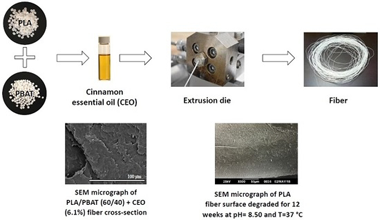
Abstract
Nowadays, the need to reduce the dependence on fuel products and to achieve a sustainable development is of special importance due to environmental concerns. Therefore, new alternatives must be sought. In this work, extruded fibers from poly (lactic acid) (PLA) and poly (butylene adipate-co-terephthalate) (PBAT) added with cinnamon essential oil (CEO) were prepared and characterized, and the hydrolytic degradation was assessed. A two-phase system was observed with spherical particles of PBAT embedded in the PLA matrix. The thermal analysis showed partial miscibility between PLA and PBAT. Mechanically, Young's modulus decreased and the elongation at break increased with the incorporation of PBAT and CEO into the blends. The variation in weight loss for the fibers was below 5% during the period of hydrolytic degradation studied with the most important changes at 37 degrees C and pH 8.50. From microscopy, the formation of cracks in the fiber surface was evidenced, especially for PLA fibers in alkaline medium at 37 degrees C. This study shows the importance of the variables that influence the performance of polyester-cinnamon essential oil-based fibers in agro-industrial applications for horticultural product preservation.
January, 2020 · DOI: 10.3390/polym12010038
Reactividad de Sólidos
Processing and properties of Bi0.98R0.02FeO3 (R = La, Sm, Y) ceramics flash sintered at similar to 650 degrees C in <5 s
Gil-Gonzalez, E; Perejon, A; Sanchez-Jimenez, PE; Raj, R; Perez-Maqueda, LAJournal of the American Ceramic Society, 103 (2020) 136-144 DOI: 10.1111/jace.16718
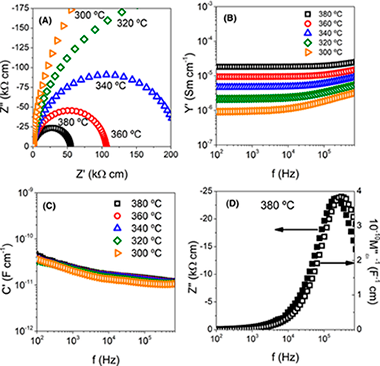
Abstract
We show that flash sintering produces single‐phase, nanograin‐sized polycrystals of isovalent‐substituted multiferroic ceramics of complex compositions. Single‐phase polycrystals of Bi0.98R0.02FeO3 (R = La, Sm, Y) were produced at a furnace temperature of ~650°C in a few seconds by the application of an electric field of 50 V cm−1, with the current limit set to 40 mA mm−2. The dielectric and insulating properties compared favorably with expected values. Impedance spectroscopy suggests electrically homogenous microstructure, except for the sample Bi0.98La0.02FeO3 that shows a small grain boundary contribution to the impedance. These results reinforce the enabling nature of flash sintering for ceramics which pose difficulties in conventional sintering because they contain low melting constituents or develop secondary phases during the sintering protocol.
January, 2020 · DOI: 10.1111/jace.16718
Materiales Ópticos Multifuncionales
Finite Size Effects on Light Propagation throughout Random Media: Relation between Optical Properties and Scattering Event Statistics
Miranda-Munoz, JM; Esteso, V; Jimenez-Solano, A; Lozano, G; Miguez, HAdvanced Optical Materials, 8 (2020) 1901196 DOI: 10.1002/adom.201901196

Abstract
This work introduces a thorough analysis of light transport in thin optically disordered media. The diffusive properties of a turbid material are generally dictated by the transport mean free path, lt. For depths larger than this characteristic length, light propagation can be considered fully randomized. There is however a range of thicknesses for which light becomes only partly randomized, as it only undergoes a single or very few scattering events. The effects of such finitude are experimentally and theoretically studied on the optical properties of the material, such as the angular distribution of scattered light. Simulations provide insight into the phenomena that occur within the optically disordered slab, like the number of scattering events that photons undergo during propagation throughout the material, as a function of the built‐in wavelength dependent scattering mean free path, lsc. This approach provides fundamental information about photon transport in finite optically random media, which can be put into practice to design diffusers with specific requirements in terms of the spectral and angular properties of the scattered light.
January, 2020 · DOI: 10.1002/adom.201901196
Materiales Avanzados
New waste-based clinkers for the preparation of low-energy cements. A step forward toward circular economy
Martinez-Martinez, S; Perez-Villarejo, L; Eliche-Quesada, D; Sanchez-Soto, PJ; Christogerou, A; Kanellopoulou, DG; Angelopoulos, GNInternational Journal of Applied Ceramic Technology, 17 (2020) 12-21 DOI: 10.1111/ijac.13390
Abstract
This paper describes the use of industrial wastes arising from different production processes of the ceramic and marble industries as raw materials for the design and formulation of new cement clinkers with a high content of dicalcium silicate (Belite). The aim was to reintroduce these wastes in the industrial sector and take advantage of them for a greater environmental benefit, as indicated by the principles of the circular economy. Formulations containing 2.5, 5 and 10 wt% of chamotte and marble sludge, respectively, and a waste-free formulation have been designed to obtain clinkers with a content of dicalcium silicate higher than 60 wt%. The different blends have been studied up to a maximum temperature of 1390 degrees C by Thermal Analysis. Other techniques such as XRD, XRF, Modified Bogue Equation, Quality Indexes (LSF, AM, SM) and Optical Microscopy have been used for the study and characterization of industrial wastes, the raw materials and the high belite-type cement dosages. The results indicate that this type of cements can be designed using different types of wastes and in this way reduce the environmental impacts caused by the extraction of raw materials and the deposition of the wastes in landfills, improving the circular economy of the construction industry.
January, 2020 · DOI: 10.1111/ijac.13390
Reactividad de Sólidos
Obituary: Prof. José Manuel Criado
Perez-Maqueda, LA; Real, C; Gotor, FJ; Alcala, MD; Malek, J; Koga, NJournal of Thermal Analysis and Calorimetry, (2020) DOI: 10.1007/s10973-019-09207-3
Reactividad de Sólidos
Influence of DSC thermal lag on evaluation of crystallization kinetics
Svoboda, R; Maqueda, LP; Podzemna, V; Perejon, A; Svoboda, OJournal of Non-Crystalline Solids, 528 (2020) 119738 DOI: 10.1016/j.jnoncrysol.2019.119738
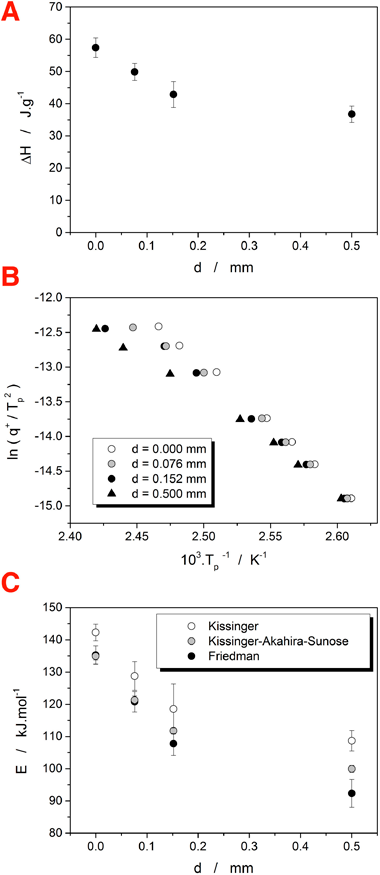
Abstract
Influence of added thermal resistance on crystallization kinetics, as measured by differential scanning calorimetry (DSC), of the Se70Te30 glass was studied. The increase of thermal resistance was achieved by adding polytetrafluorethylene discs of different thicknesses (up to 0.5 mm) in-between the DSC platform and the pan with sample. Increase of the thermal resistance led to an apparent decrease (by more than 30%) in the crystallization enthalpy. Significant change of model-free kinetics occurred: apparent activation energy E of the crystallization process decreased (by more than 20%) due to the DSC data being progressively shifted to higher temperatures with increasing heating rate. The model-based kinetics was changed only slightly; the DSC peaks retained their asymmetry and the choice of the appropriate model was not influenced by the added thermal resistance. The temperature shift caused by added thermal lag was modeled for the low-to-moderate heating rates.
January, 2020 · DOI: 10.1016/j.jnoncrysol.2019.119738
Nanotecnología en Superficies y Plasma - Materiales Nanoestructurados y Microestructura
Low gas consumption fabrication of He-3 solid targets for nuclear reactions
Fernandez, A; Hufschmidt, D; Colaux, JL; Valiente-Dobon, JJ; Godinho, V; de Haro, MCJ; Feria, D; Gadea, A; Lucas, SMaterials & Design, 186 (2020) 108337 DOI: 10.1016/j.matdes.2019.108337
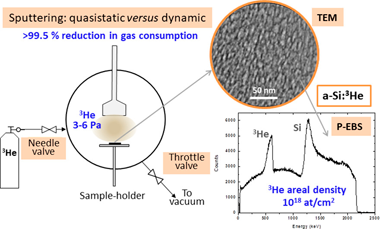
Abstract
Nanoporous solids that stabilize trapped gas nanobubbles open new possibilities to fabricate solid targets for nuclear reactions. A methodology is described based on the magnetron sputtering (MS) technique operated under quasistatic flux conditions to produce such nanocomposites films with He-3 contents of up to 16 at.% in an amorphous-silicon matrix. In addition to the characteristic low pressure (3-6 Pa) needed for the gas discharge, the method ensures almost complete reduction of the process gas flow during film fabrication. The method could produce similar materials to those obtained under classical dynamic flux conditions for MS. The drastic reduction (>99.5%) of the gas consumption is fundamental for the fabrication of targets with scarce and expensive gases. Si:He-3 and W:He-3 targets are presented together with their microstructural (scanning and transmission electron microscopy, SEM and TEM respectively) and compositional (Ion Beam Analysis, IBA) characterization. The He-3 content achieved was over 1 x 10(18) at/cm(2) for film thicknesses between 1.5 and 3 mu m for both Si and W matrices. First experiments to probe the stability of the targets for nuclear reaction studies in inverse kinematics configurations are presented.
January, 2020 · DOI: 10.1016/j.matdes.2019.108337
Nanotecnología en Superficies y Plasma
Enhanced Stability of Perovskite Solar Cells Incorporating Dopant-Free Crystalline Spiro-OMeTAD Layers by Vacuum Sublimation
Barranco, A; Lopez-Santos, MC; Idigoras, J; Aparicio, FJ; Obrero-Perez, J; Lopez-Flores, V; Contreras-Bernal, L; Rico, V; Ferrer, J; Espinos, JP; Borras, A; Anta, JA; Sanchez-Valencia, JRAdvanced Energy Materials, (2020) 1901524 DOI: 10.1002/aenm.201901524
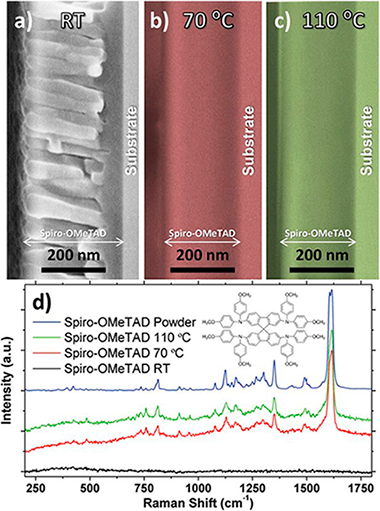
Abstract
The main handicap still hindering the eventual exploitation of organometal halide perovskite-based solar cells is their poor stability under prolonged illumination, ambient conditions, and increased temperatures. This article shows for the first time the vacuum processing of the most widely used solid-state hole conductor (SSHC), i.e., the Spiro-OMeTAD [2,2 ',7,7 '-tetrakis (N,N-di-p-methoxyphenyl-amine) 9,9 '-spirobifluorene], and how its dopant-free crystalline formation unprecedently improves perovskite solar cell (PSC) stability under continuous illumination by about two orders of magnitude with respect to the solution-processed reference and after annealing in air up to 200 degrees C. It is demonstrated that the control over the temperature of the samples during the vacuum deposition enhances the crystallinity of the SSHC, obtaining a preferential orientation along the pi-pi stacking direction. These results may represent a milestone toward the full vacuum processing of hybrid organic halide PSCs as well as light-emitting diodes, with promising impacts on the development of durable devices. The microstructure, purity, and crystallinity of the vacuum sublimated Spiro-OMeTAD layers are fully elucidated by applying an unparalleled set of complementary characterization techniques, including scanning electron microscopy, X-ray diffraction, grazing-incidence small-angle X-ray scattering and grazing-incidence wide-angle X-ray scattering, X-ray photoelectron spectroscopy, and Rutherford backscattering spectroscopy.
January, 2020 · DOI: 10.1002/aenm.201901524
Materiales Coloidales
Bimodal Nd-Doped LuVO4 Nanoprobes Functionalized with Polyacrilic Acid for X-Ray Computed Tomography and NIR Luminescent Imaging
Nuñez, NO; Cusso, F; Cantelar, E; Martin-Gracia, B; de la Fuente, JM; Corral, A; Balcerzyk, M; Ocaña, MNanomaterials, 10 (2020) 149 DOI: 10.3390/nano10010149
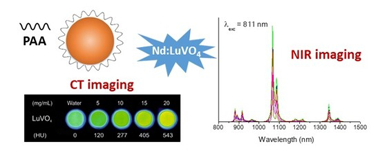
Abstract
Uniform Nd3+-doped LuVO4 nanophosphors have been synthesized for the first time in literature by using a poliol-based method at 120 degrees C from Nd3+ and vanadate precursors. After optimizing the Nd doping level, these phosphors present intense luminescence in the near-infrared biological windows. The X-ray attenuation capacity of the optimum nanophosphor has been found to be higher than that of a commercial X-ray computed tomography contrast agent. After surface coating with polyacrylic acid, such nanoparticles present high colloidal stability in physiological pH medium and high cell viability. Because of these properties, the developed Nd3+-doped LuVO4 nanoparticles have potential applications as a bimodal probe for NIR luminescent bioimaging and X-ray computed tomography.
January, 2020 · DOI: 10.3390/nano10010149
Tribología y Protección de Superficies
Tribomechanical properties of hard Cr-doped DLC coatings deposited by low-frequency HiPIMS
Santiago, JA; Fernandez-Martinez, I; Sanchez-Lopez, JC; Rojas, TC; Wennberg, A; Bellido-Gonzalez, V; Molina-Aldareguia, JM; Monclus, MA; Gonzalez-Arrabal, RSurface & Coatings Technology, 382 (2020) 124899 DOI: 10.1016/j.surfcoat.2019.124899

Abstract
Cr-doped diamond-like carbon (Cr-DLC) films with Cr contents ranging from 3 up to 20 at. % were synthesised in a codeposition process with HiPIMS (Cr deposition) and DC-pulsed technology (C deposition). The application of HiPIMS at low frequencies was observed to significantly enhance the energy density during the Cr plasma discharge due to the interaction of Cr-C species. The higher energy bombardment at low HiPIMS frequencies allowed doping with Cr the DLC structure avoiding the graphitization of the carbon structure. EELS spectroscopy was used to evaluate sp(3) content and Raman was used for sp(2) structural characterization of the films. Enhanced mechanical properties (hardness up to 30 GPa) were observed with nanoindentation for Cr-doped DLC at low frequencies. High temperature nanoindentation tests were also performed from room temperature to 425 degrees C in order to evaluate the evolution of hardness and Young Modulus with temperature. The results showed that the mechanical properties at high temperature mainly depend on the initial sp(3)-sp(2) structure. Tribological tests were carried out in air from room temperature to 250 degrees C. Cr-doped DLC coatings deposited by low-frequency HiPIMS showed lower friction and wear compared to undoped DLC.
January, 2020 · DOI: 10.1016/j.surfcoat.2019.124899
Materiales Ópticos Multifuncionales
Dipole reorientation and local density of optical states influence the emission of light-emitting electrochemical cells
Jimenez-Solano, Alberto; Martinez-Sarti, Laura; Pertegas, Antonio; Lozano, Gabriel; Bolink, Henk J; Miguez, HernanPhysical Chemistry Chemical Physics, 22 (2020) 92-96 DOI: 10.1039/c9cp05505c
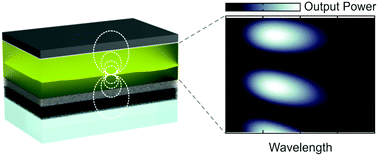
Abstract
Herein, we analyze the temporal evolution of the electroluminescence of light-emitting electrochemical cells (LECs), a thin-film light-emitting device, in order to maximize the luminous power radiated by these devices. A careful analysis of the spectral and angular distribution of the emission of LECs fabricated under the same experimental conditions allows describing the dynamics of the spatial region from which LECs emit, i.e. the generation zone, as bias is applied. This effect is mediated by dipole reorientation within such an emissive region and its optical environment, since its spatial drift yields a different interplay between the intrinsic emission of the emitters and the local density of optical states of the system. Our results demonstrate that engineering the optical environment in thin-film light-emitting devices is key to maximize their brightness.
January, 2020 · DOI: 10.1039/c9cp05505c
Fotocatálisis Heterogénea: Aplicaciones
Effect of synthesis pH on the physicochemical properties of a synthesized Bi2WO6 and the type of substrate chosen, in assessing its photo-catalytic activities
Jaramillo-Páez, C.; Navío, J.A.; Hidalgo, M.C.Arabian Journal of Chemistry, 13 (2020) 431-443 DOI: 10.1016/j.arabjc.2017.05.014
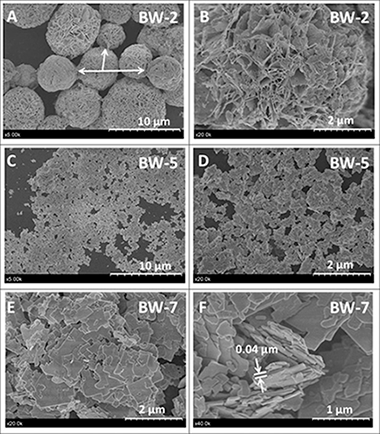
Abstract
Crystalline orthorhombic Bi2WO6 powders were synthesized by a hydrothermal method from aqueous solutions of Bi(NO3)35H2O and Na2WO42H2O over a range of three selected pH values (2.0, 5.0 and 7.0), using NaOH as precipitating agent. The as-prepared catalysts were characterized by XRD, BET, FE-SEM, TEM, XPS and UV-vis spectroscopy. The effect of pH-synthesis on crystallinity, morphologies, surface area and optical absorption properties, were investigated.
Although the pH has a marked influence on morphology, the nature of the precipitating agent (NaOH or TEA) also influences the morphology and surface structure composition, as it is observed in the present work. Three different probe molecules were used to evaluate the photocatalytic properties under two illumination conditions (UV and Visible): Methyl Orange and Rhodamine B were chosen as dye substrates and Phenol as a transparent substrate. The photo-catalytic activities are strongly dependent not only on the pH used in the synthesis but also on the nature of the chosen substrate in assessing the photo-catalytic activities. Results were compared with those obtained when using TiO2(P25, Evonik) in the same experimental conditions. The photocatalytic activity of one of the synthesised samples has been evaluated by exposing a mixture of Rhodamine B and Phenol in water, to different illumination conditions. Our results provide new evidences about the issue of whether dyes are suitable substrates to assess the activity of a photo-catalyst.
January, 2020 · DOI: 10.1016/j.arabjc.2017.05.014
Reactividad de Sólidos
Development of Ti(C,N)-based cermets with (Co,Fe,Ni)-based high entropy alloys as binder phase
de la Obra, AG; Sayagues, MJ; Chicardi, E; Gotor, FJJournal of Alloys and Compounds, 814 (2020) 152218 DOI: 10.1016/j.jallcom.2019.152218

Abstract
High entropy alloys have been proposed as novel binder phases in cemented carbides and cermets. Many aspects related to the stability of these alloys during the liquid phase sintering process are still unclear and were addressed in this work. Consolidated Ti(C,N)-based cermets using four different (Co,Fe,Ni)based high entropy alloys as the binder phase were obtained. The chosen alloys - CoCrCuFeNi, CoCrFeNiV, CoCrFeMnNi and CoFeMnNiV - were previously synthesized through mechanical alloying and a single alloyed solid solution phase with fcc structure and nanometric character was always obtained. The powdered alloys and the consolidated cermets were analyzed by X-ray diffraction, scanning electron microscopy, X-ray energy dispersive spectrometry and transmission electron microscopy. Differential thermal analysis was employed to determine the melting point of the four high entropy alloys that ranged between 1310 degrees C and 1375 degrees C. Although a high temperature of 1575 degrees C was required to obtain the highest cermet densification by pressureless sintering, porosity still remained in most of the cermets. Best densification was achieved when CoCrFeNiV was used as the binder phase. During liquid phase sintering, different compositional changes were observed in the ceramic and binder phases. A core-rim microstructure was observed in cermets containing V in the alloys (CoCrFeNiV and CoFeMnNiV), since this element was incorporated to the carbonitride structure during sintering. A slight Cr segregation was detected in cermets containing Cr, leading to CrTi-rich alloys in small binder regions. However, a great Cu segregation was produced when CoCrCuFeNi was used, and the formation of two different fcc alloys -a Cu-rich and a Cu-depleted- was observed. Finally, a loss of Mn was also evidenced in CoCrFeMnNi and CoFeMnNiV, probably due to its sublimation at the sintering temperature.
January, 2020 · DOI: 10.1016/j.jallcom.2019.152218
2019
2019
Materiales de Diseño para la Energía y Medioambiente
Porous Graphene-like Carbon from Fast Catalytic Decomposition of Biomass for Energy Storage Applications
Gomez-Martin, A; Martinez-Fernandez, J; Ruttert, M; Winter, M; Placke, T; Ramirez-Rico, JACS Omega, 4 (2019) 21446-21458 DOI: 10.1021/acsomega.9b03142

Abstract
A novel carbon material made of porous graphene-like nanosheets was synthesized from biomass resources by a simple catalytic graphitization process using nickel as a catalyst for applications in electrodes for energy storage devices. A recycled fiberboard precursor was impregnated with saturated nickel nitrate followed by high-temperature pyrolysis. The highly exothermic combustion of in situ formed nitrocellulose produces the expansion of the cellulose fibers and the reorganization of the carbon structure into a three-dimensional (3D) porous assembly of thin carbon nanosheets. After acid washing, nickel particles are fully removed, leaving nanosized holes in the wrinkled graphene-like sheets. These nanoholes confer the resulting carbon material with approximate to 75% capacitance retention, when applied as a supercapacitor electrode in aqueous media at a specific current of 100 A.g(-1) compared to the capacitance reached at 20 mA.g(-1), and approximate to 35% capacity retention, when applied as a negative electrode for lithium-ion battery cells at a specific current of 3720 mA.g(-1) compared to the specific capacity at 37.2 mA.g(-1). These findings suggest a novel way for synthesizing 3D nanocarbon networks from a cellulosic precursor requiring low temperatures and being amenable to large-scale production while using a sustainable starting precursor such as recycled fiberwood.
December, 2019 · DOI: 10.1021/acsomega.9b03142
Química de Superficies y Catálisis
Dry Reforming of Ethanol and Glycerol: Mini-Review
Yu, J; Odriozola, JA; Reina, TRCatalysts, 9 (2019) art. 1015 DOI: 10.3390/catal9121015

Abstract
Dry reforming of ethanol and glycerol using CO2 are promising technologies for H-2 production while mitigating CO2 emission. Current studies mainly focused on steam reforming technology, while dry reforming has been typically less studied. Nevertheless, the urgent problem of CO2 emissions directly linked to global warming has sparked a renewed interest on the catalysis community to pursue dry reforming routes. Indeed, dry reforming represents a straightforward route to utilize CO2 while producing added value products such as syngas or hydrogen. In the absence of catalysts, the direct decomposition for H-2 production is less efficient. In this mini-review, ethanol and glycerol dry reforming processes have been discussed including their mechanistic aspects and strategies for catalysts successful design. The effect of support and promoters is addressed for better elucidating the catalytic mechanism of dry reforming of ethanol and glycerol. Activity and stability of state-of-the-art catalysts are comprehensively discussed in this review along with challenges and future opportunities to further develop the dry reforming routes as viable CO2 utilization alternatives.
December, 2019 · DOI: 10.3390/catal9121015
Tribología y Protección de Superficies
Silver effect on the tribological and antibacterial properties of a-C:Ag coatings
Dominguez-Meister, S; Rojas, TC; Frias, JE; Sanchez-Lopez, JCTribology International, 140 (2019) UNSP 105837 DOI: 10.1016/j.triboint.2019.06.030

Abstract
a-C:Ag coatings (1.2-23.4 at.% of Ag) were deposited using magnetron sputtering. Ag nanoparticles appear embedded in the carbon matrix or segregated to the column boundaries or surface. The silver doping has not promoted significant changes of the sp(2)/sp(3) ratio although a decrease of the hardness is observed (from 17 to 7 GPa). The tribological behavior did not show a clear dependence on the silver concentration in unlubricated or lubricated conditions (fetal bovinum serum) against alumina or UHMWPE balls. Ag nanoparticle dispersion enhanced the bactericide behavior as determined by the released Ag+ ion in the fluid media. There is no clear effect of friction rubbing on the released silver indicating that diffusion and top segregation are prevalent mechanisms for its dissolution.
December, 2019 · DOI: 10.1016/j.triboint.2019.06.030
Nanotecnología en Superficies y Plasma
3D Organic Nanofabrics: Plasma-Assisted Synthesis and Antifreezing Behavior of Superhydrophobic and Lubricant-Infused Slippery Surfaces
Alcaire, M; Lopez-Santos, C; Aparicio, FJ; Sanchez-Valencia, JR; Obrero, JM; Saghi, Z; Rico, VJ; de la Fuente, G; Gonzalez-Elipe, AR; Barranco, A; Borras, ALangmuir, 35 (2019) 16876-16885 DOI: 10.1021/acs.langmuir.9b03116

Abstract
Herein, we present the development of supported organic nanofabrics formed by a conformal polymer-like interconnection of small-molecule organic nanowires and nanotrees. These organic nanostructures are fabricated by a combination of vacuum and plasma-assisted deposition techniques to generate step by step, single-crystalline organic nanowires forming one-dimensional building blocks, organic nanotrees applied as three-dimensional templates, and the polymer-like shell that produces the final fabric. The complete procedure is carried out at low temperatures and is compatible with an ample variety of substrates (polymers, metal, ceramics; either planar or in the form of meshes) yielding flexible and low solid-fraction three-dimensional nanostructures. The systematic investigation of this progressively complex organic nanomaterial delivers key clues relating their wetting, nonwetting, and anti-icing properties with their specific morphology and outer surface composition. Water contact angles higher than 150° are attainable as a function of the nanofabric shell thickness with outstanding freezing-delay times (FDT) longer than 2 h at −5 °C. The role of the extremely low roughness of the shell surface is settled as a critical feature for such an achievement. In addition, the characteristic interconnected microstructure of the nanofabrics is demonstrated as ideal for the fabrication of slippery liquid-infused porous surfaces (SLIPS). We present the straightforward deposition of the nanofabric on laser patterns and the knowledge of how this approach provides SLIPS with FDTs longer than 5 h at −5 °C and 1 h at −15 °C.
December, 2019 · DOI: 10.1021/acs.langmuir.9b03116
Materiales de Diseño para la Energía y Medioambiente
Design swelling micas: Insights on heavy metals cation exchange reaction
Osuna, FJ; Pavon, E; Alba, MDApplied Clay Science, 182 (2019) 105298 DOI: 10.1016/j.clay.2019.105298
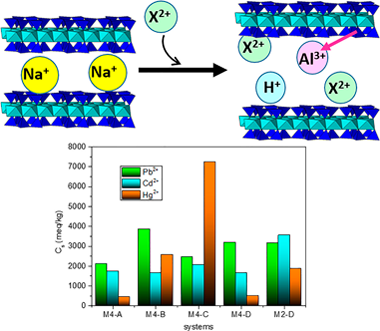
Abstract
Heavy metal pollution has become one of the most serious environmental problems, demanding specialized remediation mechanisms. Among the studied treatments, ion-exchange processes have been widely used due to their high remediation capacity, efficiency and fast kinetic. Here, the potential use of a new family of design micas as cation exchanger has been analysed. Micas with a layer charge in the range of brittle micas have been synthesized and their heavy metals cation exchange capacity analysed as a function of the nature of the heavy metal cations (Pb2+, Cd2+ or Hg2+), the nature of the counterions (Cl− or NO3−), concentration of the solutions and the micas layer charge. A cation exchange ratio between 35% and 154% of their cation exchange capacity (CEC) was achieved, being more efficient when mica layer charge diminished. In general, the maximum adsorption capacity followed the trend: Hg2+ > Pb2+ > Cd2+. The efficiency of the cation exchange and adsorption mechanism of the synthetic micas depended on the experimental conditions and they were more efficient than raw and modified natural clay minerals.
December, 2019 · DOI: 10.1016/j.clay.2019.105298
Materiales de Diseño para la Energía y Medioambiente
Understanding segregation processes in SAMs formed by mixtures of hydroxylated and non-hydroxylated fatty acids
Bueno, OVM; Benitez, JJ; San-Miguel, MARSC Advances, 9 (2019) 39252-39263 DOI: 10.1039/c9ra06799j
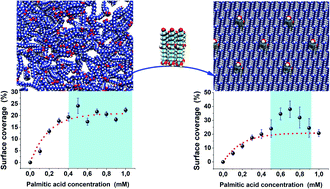
Abstract
In this paper, we focus on the segregation processes emerging when preparing mixtures with different compositions of aleuritic (9,10,16 trihydroxyhexadecanoic) (ALE) and palmitic (hexadecanoic) (PAL) acids. The combination of atomic force microscopy (AFM) and molecular dynamics (MD) simulations enabled us to prove the role of the functional groups in the formation of self-assembled monolayers (SAMs) on muscovite mica surfaces. MD simulations indicate that segregation processes are favored in high ALE composition mixtures in agreement with the experimental evidence, whereas low ALE compositions promote the co-existence between segregated and dispersed systems. The secondary hydroxyl groups play a central role in the self-assembling mechanism because they control the formation of hydrogen bonding networks guarantying system stability.
December, 2019 · DOI: 10.1039/c9ra06799j
Reactividad de Sólidos
Low temperature synthesis of an equiatomic (TiZrHfVNb)C5 high entropy carbide by a mechanically-induced carbon diffusion route
Chicardi, E; Garcia-Garrido, C; Gotor, FJCeramics International, 45 (2019) 21858-21863 DOI: 10.1016/j.ceramint.2019.07.195
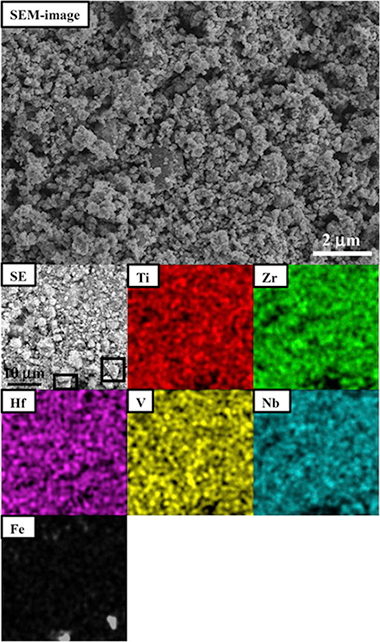
Abstract
A novel, homogeneous, nanostructured and equiatomic (TiZrHfVNb)C-5 High Entropy Carbide (HEC) was successfully synthesised in a powder form by a mechanosynthesis process from the elemental mixture. This synthesis method for HECs, not previously reported, is simple, reproducible and carried out at room temperature. During milling, the transition metals (Ti, Zr, Hf, V and Nb) alloying and the diffusion of carbon (introduced as graphite) into the alloy structure are simultaneously induced, obtaining the expected (TiZrHfVNb)C-5 HEC. The room temperature method employed contrasts with those reported in the bibliography from binary carbides that are carried out at a very high temperature (1800-2200 degrees C), with the consequent energy savings.
December, 2019 · DOI: 10.1016/j.ceramint.2019.07.195
Nanotecnología en Superficies y Plasma
Graphene Formation Mechanism by the Electrochemical Promotion of a Ni Catalyst
Espinos, JP; Rico, VJ; Gonzalez-Cobos, J; Sanchez-Valencia, JR; Perez-Dieste, V; Escudero, C; de Lucas-Consuegra, A; Gonzalez-Elipe, ARACS Catalysis, 9 (2019) 11447-11454 DOI: 10.1021/acscatal.9b03820
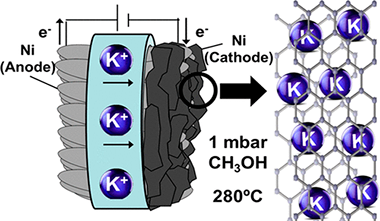
Abstract
In this work, we show that multilayer graphene forms by methanol decomposition at 280 degrees C on an electrochemically promoted nickel catalyst film supported on a K-beta Al2O3 solid electrolyte. In operando near ambient pressure photoemission spectroscopy and electrochemical measurements have shown that polarizing negatively the Ni electrode induces the electrochemical reduction and migration of potassium to the nickel surface. This elemental potassium promotes the catalytic decomposition of methanol into graphene and also stabilizes the graphene formed via diffusion and direct K-C interaction. Experiments reveal that adsorbed methoxy radicals are intermediate species in this process and that, once formed, multilayer graphene remains stable after electrochemical oxidation and back migration of potassium to the solid electrolyte upon positive polarization. The reversible diffusion of ca. 100 equivalent monolayers of potassium through the carbon layers and the unprecedented low-temperature formation of graphene and other carbon forms are mechanistic pathways of high potential impact for applications where mild synthesis and operation conditions are required.
December, 2019 · DOI: 10.1021/acscatal.9b03820
Nanotecnología en Superficies y Plasma
Hydrophobic and Icephobic Behaviour of Polyurethane-Based Nanocomposite Coatings
Przybyszewski, B; Boczkowska, A; Kozera, R; Mora, J; Garcia, P; Aguero, A; Borras, ACoatings, 9 (2019) 811 DOI: 10.3390/coatings9120811

Abstract
In this paper, hydrophobic nanocomposite coatings based on polyurethane (PUR) modified by nano-silica and silane-based compounds were manufactured by spraying. The main challenge was to assess and improve the hydrophobic as well as anti-icing properties of initially hydrophilic polymer coatings. The prepared nanocomposite coatings were characterized by means of scanning electron microscopy (SEM), optical profilometry and X-ray photoelectron spectroscopy (XPS). The results obtained showed that in order to achieve hydrophobicity, appropriate amounts of nano-silica must be incorporated in the coating, and complete coverage by nano-silica particles is necessary for achieving hydrophobicity. Coating adhesion and the durability of the hydrophobic behaviour were also studied by scratch test and frosting/defrosting cycles, respectively. The results show that use of both nano-silica and silane-based compounds improve the hydrophobic and anti-icing properties of the coating as compared to a non-modified PUR topcoat. A synergistic effect of both additives was observed. It was also found that the anti-icing behaviour does not necessarily correlate with surface roughness and the materials' wetting properties.
December, 2019 · DOI: 10.3390/coatings9120811
Química de Superficies y Catálisis
Colombian metallurgical coke as catalysts support of the direct coal liquefaction
Rico, D; Agamez, Y; Romero, E; Centeno, MA; Odriozola, JA; Diaz, JDFuel, 255 (2019) 115748 DOI: 10.1016/j.fuel.2019.115748
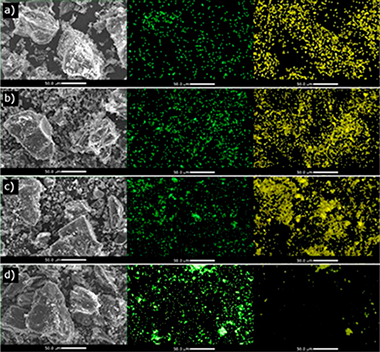
Abstract
A Colombian metallurgical coke was modified in its surface chemistry and was used as support of iron sulfide catalysts for direct coal liquefaction. The modification was made by treatments with diluted oxygen and HNO3 at different conditions. Changes in surface chemistry were studied by determining the point of zero charge (PZC), the isoelectric point (IEP), thermogravimetric analysis (TGA), temperature programmed decomposition-mass spectrometry (TPD-MS), Diffuse-reflectance infrared Fourier transform spectroscopy (DRIFTS) and nitrogen adsorption at 77 K. The results show that the materials obtained have a wide range of functional groups incorporated in a different proportion and quantity. The textural parameters indicate that treatment with diluted oxygen increases the surface area and incorporates micropores while the samples treated with HNO3 maintain the textural properties of the original material. The catalysts were also characterized by Raman spectroscopy. It was found that impregnation with the iron sulfide precursor does not significantly affect the Raman characteristics of the support. Additionally, XRD analysis shows smaller pyrite crystallites in the coke enriched with oxygenated groups of phenol and lactone indicating better dispersion of the active phase. The amount of oxygen chemisorbed per gram of catalyst shows that both, oxygen and nitric acid treatments, improve the relative dispersion of the active phase. It was found that the presence of the catalysts increases the conversion and yields towards oils and gases with respect to those of the tests without catalysts. Cokes modified by dilute oxygen gaseous treatment contain surface phenol and lactone groups and present the highest yield to oils.
November, 2019 · DOI: 10.1016/j.fuel.2019.115748
Nanotecnología en Superficies y Plasma
Ultrastable CoxSiyOz Nanowires by Glancing Angle Deposition with Magnetron Sputtering as Novel Electrocatalyst for Water Oxidation
Cano, M; Garcia-Garcia, FJ; Rodriguez-Padron, D; Gonzalez-Elipe, AR; Giner-Casares, JJ; Luque, RChemcatchem DOI: 10.1002/cctc.201901730

Abstract
Cobalt is one of the most promising non-noble metal as electrocatalyst for water oxidation. Herein, a highly stable silicon-cobalt mixed oxide thin film with a porous columnar nanostructure is proposed as electrocatalyst for oxygen evolution reaction (OER). CoOx and CoxSiyOz layers with similar thickness were fabricated at room temperature by magnetron sputtering in a glancing angle configuration (MS-GLAD) on tin-doped indium oxide (ITO) substrates. After characterization, a comparative study of the electrocatalytic performance for OER of both layers was carried out. The excellent long-term stability as electrocatalyst for OER of the porous CoxSiyOz thin film demonstrates that the presence of silicon on the mixed oxide network increases the mechanical stability of the Si/Co layer, whilst maintaining a considerable electrocatalytic response.
November, 2019 · DOI: 10.1002/cctc.201901730
Reactividad de Sólidos
Design of highly stabilized nanocomposite inks based on biodegradable polymer-matrix and gold nanoparticles for Inkjet Printing
Begines, Belen; Alcudia, Ana; Aguilera-Velazquez, Raul; Martinez, Guillermo; He, Yinfeng; Wildman, Ricky; Sayagues, Maria-Jesus; Jimenez-Ruiz, Aila; Prado-Gotor, RafaelScientific Reports, 9 (2019) 16097 DOI: 10.1038/s41598-019-52314-2
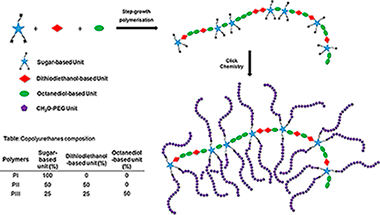
Abstract
Nowadays there is a worldwide growing interest in the Inkjet Printing technology owing to its potentially high levels of geometrical complexity, personalization and resolution. There is also social concern about usage, disposal and accumulation of plastic materials. In this work, it is shown that sugar-based biodegradable polyurethane polymers exhibit outstanding properties as polymer-matrix for gold nanoparticles composites. These materials could reach exceptional stabilization levels, and demonstrated potential as novel robust inks for Inkjet based Printing. Furthermore, a physical comparison among different polymers is discussed based on stability and printability experiments to search for the best ink candidate. The University of Seville logo was printed by employing those inks, and the presence of gold was confirmed by ToF-SIMS. This approach has the potential to open new routes and applications for fabrication of enhanced biomedical nanometallic-sensors using stabilized AuNP.
November, 2019 · DOI: 10.1038/s41598-019-52314-2
Materiales Avanzados
Phyllite clays as raw materials replacing cement in mortars: Properties of new impermeabilizing mortars
Arce, Carolina; Garzon, Eduardo; Sanchez-Soto, Pedro J.Construction and Building Materials, 224 (2019) 348-358 DOI: 10.1016/j.conbuildmat.2019.07.081
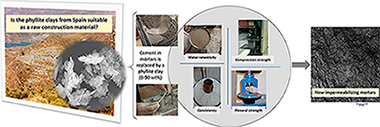
Abstract
The aim of this investigation was to determine the suitability of phyllite clays as a raw construction material. For that purpose, the cement in mortars was replaced by a phyllite clay (0–90 wt%) making this study the first of its kind to be performed. These materials were prepared with different water proportions according to the water content and water/cement and water/binder (cement plus phyllite clay) relationships. A comparative study of the most important properties of the resulting experimental mortars was carried out, such as apparent density, water retentivity, consistency and mechanical strength (flexural and compressive strength), along with an evaluation of the pozzolanic activity and permeability. The results showed that the increase of phyllite decreases the apparent density, the consistency and mechanical properties of the mortar, while water retentivity fluctuates. Good correlations (R2 > 0.84) were obtained between flexural and compressive strength for the mortars after 28 days of curing. Pozzolanic activity was observed at cement replacement of 80 wt% of phyllite. Moreover, new impermeabilizing mortars constituted by phyllite clay and cement have been obtained according to the low coefficients of permeability. Taking into account the findings of this research, phyllite clays can be applied as raw construction materials with savings derived from replacing cement in mortars and the low energy consumption involved in their production. However, the present study concluded that the use of phyllite clays did not improve the mechanical strength of these new mortars but, in contrast, they can be applied for impermeabilization purposes in Construction and Civil Engineering.
November, 2019 · DOI: 10.1016/j.conbuildmat.2019.07.081
Materiales Coloidales
Encapsulation of Upconversion Nanoparticles in Periodic Mesoporous Organosilicas
Rahmani, S; Jimenez, CM; Aggad, D; Gonzalez-Mancebo, D; Ocana, M; Ali, LMA; Nguyen, C; Nieto, AIB; Francolon, N; Oliveiro, E; Boyer, D; Mahiou, R; Raehm, L; Gary-Bobo, M; Durand, JO; Charnay, CMolecules, 24 (2019) 22 DOI: 10.3390/molecules24224054
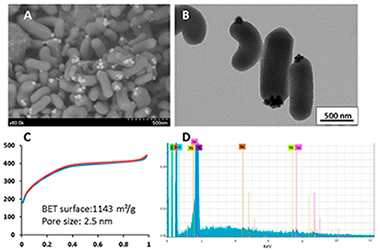
Abstract
(1) Background: Nanomedicine has recently emerged as a promising field, particularly for cancer theranostics. In this context, nanoparticles designed for imaging and therapeutic applications are of interest. We, therefore, studied the encapsulation of upconverting nanoparticles in mesoporous organosilica nanoparticles. Indeed, mesoporous organosilica nanoparticles have been shown to be very efficient for drug delivery, and upconverting nanoparticles are interesting for near-infrared and X-ray computed tomography imaging, depending on the matrix used. (2) Methods: Two different upconverting-based nanoparticles were synthesized with Yb3+-Er3+ as the upconverting system and NaYF4 or BaLuF5 as the matrix. The encapsulation of these nanoparticles was studied through the sol-gel procedure with bis(triethoxysilyl)ethylene and bis(triethoxysilyl)ethane in the presence of CTAB. (3) Results: with bis(triethoxysilyl)ethylene, BaLuF5: Yb3+-Er3+, nanoparticles were not encapsulated, but anchored on the surface of the obtained mesoporous nanorods BaLuF5: Yb3+-Er3+@Ethylene. With bis(triethoxysilyl)ethane, BaLuF5: Yb3+-Er3+ and NaYF4: Yb3+-Er(3+)nanoparticles were encapsulated in the mesoporous cubic structure leading to BaLuF5: Yb3+-Er3+@Ethane and NaYF4: Yb3+-Er3+@Ethane, respectively. (4) Conclusions: upconversion nanoparticles were located on the surface of mesoporous nanorods obtained by hydrolysis polycondensation of bis(triethoxysilyl)ethylene, whereas encapsulation occurred with bis(triethoxysilyl)ethane. The later nanoparticles NaYF4: Yb3+-Er3+@Ethane or BaLuF5: Yb3+-Er3+@Ethane were promising for applications with cancer cell imaging or X-ray-computed tomography respectively.
November, 2019 · DOI: 10.3390/molecules24224054
Reactividad de Sólidos
Graphene nanoplatelets for electrically conductive 3YTZP composites densified by pressureless sintering
Lopez-Pernia, C; Gallardo-Lopez, A; Morales-Rodriguez, A; Poyato, RJournal of the European Ceramic Society, 39 (2015) 4435-4439 DOI: 10.1016/j.jeurceramsoc.2019.05.067
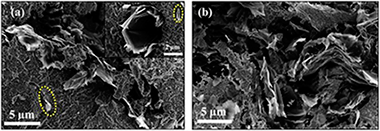
Abstract
3 mol% yttria tetragonal zirconia polycrystalline (3YTZP) ceramic composites with 2.5, 5 and 10 vol% graphene nanoplatelets (GNP) were pressureless sintered in argon atmosphere between 1350 and 1450 degrees C. The effects of the GNP content and the sintering temperature on the densification, microstructure and electrical properties of the composites were investigated. An isotropic distribution of GNP surrounding ceramic regions was exhibited regardless the GNP content and sintering temperature used. Electrical conductivity values comparable to the ones of fully dense composites prepared by more complex techniques were obtained, even though full densification was not achieved. While the composite with 5 vol% GNP exhibited electrical anisotropy with a semiconductor-type behaviour, the composite with 10 vol% GNP showed an electrically isotropic metallic-type behaviour.
November, 2019 · DOI: 10.1016/j.jeurceramsoc.2019.05.067
Nanotecnología en Superficies y Plasma
Kinetic energy-induced growth regimes of nanocolumnar Ti thin films deposited by evaporation and magnetron sputtering
Alvarez, R.; Garcia-Valenzuela, A.; Rico, V; Garcia-Martin, J. M.; Cotrino, J.; Gonzalez-Elipe, A. R.; Palmero, A.Nanotechnology, 30 (2019) 475603 DOI: 10.1088/1361-6528/ab3cb2
Abstract
We experimentally analyze different growth regimes of Ti thin films associated to the existence of kinetic energy-induced relaxation mechanisms in the material's network when operating at oblique geometries. For this purpose, we have deposited different films by evaporation and magnetron sputtering under similar geometrical arrangements and at low temperatures. With the help of a well-established growth model we have found three different growth regimes: (i) low energy deposition, exemplified by the evaporation technique, carried out by species with typical energies in the thermal range, where the morphology and density of the film can be explained by solely considering surface shadowing processes, (ii) magnetron sputtering under weak plasma conditions, where the film growth is mediated by surface shadowing mechanisms and kinetic-energy-induced relaxation processes, and (iii) magnetron sputtering under intense plasma conditions, where the film growth is highly influenced by the plasma, and whose morphology is defined by nanocolumns with similar tilt than evaporated films, but with much higher density. The existence of these three regimes explains the variety of morphologies of nanocolumnar Ti thin films grown at oblique angles under similar conditions in the literature.
November, 2019 · DOI: 10.1088/1361-6528/ab3cb2
Materiales Coloidales
Monodisperse Gold Cuboctahedral Nanocrystals Directly Synthesized in Reverse Micelles: Preparation, Colloidal Dispersion in Organic Solvents and Water, Reversible Self-Assembly and Plasmonic Properties
Luna, C; Castaneda-Rodriguez, D; Barriga-Castro, ED; Nunez, NO; Mendoza-Resendez, RLangmuir, 34 (2019) 14291-14299 DOI: 10.1021/acs.langmuir.9b02374
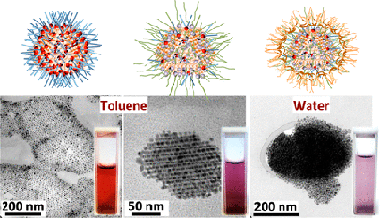
Abstract
The synthesis of organic-solvent-dispersible gold nanoparticles in reverse micelles of didodecyldimethylammonium bromide (DDAB) is revisited in the present investigation. Some parameters of synthesis, specifically the reaction volume and the concentration of the reducing agent, were slightly modified obtaining directly monodisperse gold nanocrystals (AuNCs) without the need to use additional active surfactants or additional treatments such as digestive ripening. Interestingly, most of the obtained AuNCs display the same exposed crystalline faces composed of six bounding facets (four {111} faces and two {002} faces), corresponding to single-crystalline face-centered cubic nanoparticles with a cuboctahedron shape. When these AuNCs are subsequently functionalized with 1-decanethiol (C10H21SH) or 1-dodecanethiol (C12H25SH), they don’t experience significant changes in their size or crystalline texture, however, they self-aggregate directly in the suspension at room temperature into faceted supramolecular structures and exhibit collective plasmonic excitations. Such self-organization is reversible under heating treatments allowing the observation of the influence of the AuNCs aggregation state on their plasmonic properties. Fourier transform infrared spectroscopy reveals that thiols only replace partially the DDAB molecules, and thus, DDAB molecules remain present in the thiol-capped AuNCs. To turn the thiol-capped nanocrystals into water-dispersible nanocrystals and extend their technological potential, they are stabilized with poloxamer 407 obtaining highly stable purple colloids in water.
November, 2019 · DOI: 10.1021/acs.langmuir.9b02374
Materiales Nanoestructurados y Microestructura
Morphological effects on the photocatalytic properties of SnO2 nanostructures
Kar, A; Olszowka, J; Sain, S; Sloman, SRI; Montes, O; Fernandez, A; Pradhan, SK; Wheatley, AEHJournal of Alloys and Compounds, 810 (2019) UNSP 151718 DOI: 10.1016/j.jallcom.2019.151718

Abstract
The photocatalytic properties of SnO2 nanocrystals are tuned by varying their morphology and microstructure. SnO2 nanoparticles and nanowedges have been synthesized using hydrothermal methods, while microwave irradiation techniques have given nanospheres. Detailed structural and chemical characterization of these different morphologies has been accomplished. The influence of SnO2 morphology on photocatalytic activity has been examined by monitoring the degradation of aqueous methylene blue dye. Results demonstrate that changing the morphology of the SnO2 modulates both surface area and levels of surface defects and that these alterations are reflected in the photocatalytic properties of the materials. The degradation of methylene blue dye (98%) in the presence of SnO2 nanoparticles under simulated solar irradiation is superior to previously reported photocatalyst performance and is comparable to that of standard TiO2 (Degussa P-25). The SnO2 nanoparticles perform better than both the nanowedges and nanospheres and this is attributed to the number of surface defects available to the high surface area material. They also reveal outstanding recyclability and stability.
November, 2019 · DOI: 10.1016/j.jallcom.2019.151718
Materiales Coloidales - Materiales Ópticos Multifuncionales
Synthesis, functionalization and properties of uniform europium-doped sodium lanthanum tungstate and molybdate (NaLa(XO4)(2), X = Mo,W) probes for luminescent and X-ray computed tomography bioimaging
Laguna, M; Nunez, NO; Becerro, AI; Lozano, G; Moros, M; de la Fuente, JM; Corral, A; Balcerzyk, M; Ocana, MJournal of Colloid and Interface Science, 554 (2019) 520-530 DOI: 10.1016/j.jcis.2019.07.031
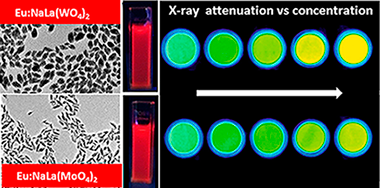
Abstract
A one-pot simple procedure for the synthesis of uniform, ellipsoidal Eu3+-doped sodium lanthanum tungstate and molybdate (NaLa(XO4)(2), X = W, Mo) nanophosphors, functionalized with carboxylate groups, is described. The method is based on a homogeneous precipitation process at 120 degrees C from appropriate Na+ Ln(3+) and tungstate or molybdate precursors dissolved in ethylene glycol/water mixtures containing poly acrylic acid. A comparative study of the luminescent properties of both luminescent materials as a function of the Eu3+ doping level has been performed to find the optimum nanophosphor, whose efficiency as X-ray computed tomography contrast agent is also evaluated and compared with that of a commercial probe. Finally, the cell viability and colloidal stability in physiological pH medium of the optimum samples have also been studied to assess their suitability for biomedical applications.
October, 2019 · DOI: 10.1016/j.jcis.2019.07.031
Química de Superficies y Catálisis
The Success Story of Gold-Based Catalysts for Gas- and Liquid-Phase Reactions: A Brief Perspective and Beyond
Price, CAH; Pastor-Perez, L; Ivanova, S; Reina, TR; Liu, JFrontiers in Chemistry, 7 (2019) 691 DOI: 10.3389/fchem.2019.00691

Abstract
Gold has long held the fascination of mankind. For millennia it has found use in art, cosmetic metallurgy and architecture; this element is seen as the ultimate statement of prosperity and beauty. This myriad of uses is made possible by the characteristic inertness of bulk gold; allowing it to appear long lasting and above the tarnishing experienced by other metals, in part providing its status as the most noble metal.
October, 2019 · DOI: 10.3389/fchem.2019.00691
Reactividad de Sólidos
The influence of mechanical activation process on the microstructure and mechanical properties of bulk Ti2AlN MAX phase obtained by reactive hot pressing
Salvo, C; Chicardi, E; Garcia-Garrido, C; Jimenez, JA; Aguilar, C; Usuba, J; Mangalaraja, RVCeramics International, 45 (2019) 17793-17799 DOI: 10.1016/j.ceramint.2019.05.350
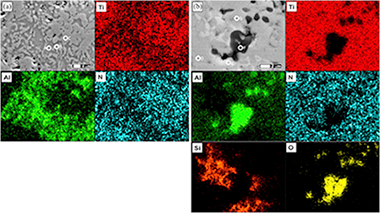
Abstract
The effect of mechanical activation process on the microstructure and mechanical properties of bulk nanostructured Ti2AlN compound has been investigated in this work. The mixture of Ti and AlN powders was prepared in a 2:1 molar ratio, and a part of this powder was subjected to a high-energy milling process under argon atmosphere for 10 h using agate as grinding media. Finally, the densification and formation of the ternary Ti2AlN MAX phase through solid state reaction of both unmilled and milled powders were carried out by hot pressing under 15 or 30 MPa at 1200 degrees C for 2 h. The microstructure of precursor powder mixtures and the consolidated samples was characterized by using X-ray diffraction (XRD) and a scanning electron microscope equipped with an energy dispersive X-ray spectroscopy (SEM/EDS). The X-ray diffraction patterns were fitted using the Rietveld refinement for phase quantification and to determine their most important microstructural parameters. Microstructure and mechanical properties of the consolidated samples were correlated with the load used for the hot pressing process. The substantial increase of hardness, the higher densification and the lower grain sizes observed in the samples prepared from the activated powders were attributed to the formation of second phases like Ti5Si3 and Al2O3.
October, 2019 · DOI: 10.1016/j.ceramint.2019.05.350
Propiedades mecánicas, modelización y caracterización de cerámicos avanzados
Sintering kinetics, defect chemistry and room-temperature mechanical properties of titanium nitride prepared by spark plasma sintering
Chavez, JMM; Moshtaghioun, BM; Hernandez, FLC; Garcia, DGJournal of Alloys and Compounds, 807 (2019) 151666 DOI: 10.1016/j.jallcom.2019.151666
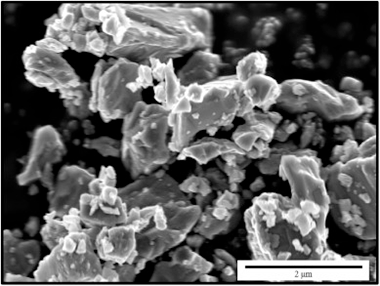
Abstract
Fully dense titanium nitride polycrystals have been prepared by spark plasma sintering. The kinetics of the sintering process and the optimized conditions for SPS processing have been put forward. Microstructural analyses of the resulting samples have unambiguously shown the coexistence of titanium as Ti2+, Ti3+ and Ti4+, thus driving the presence of cation vacancies. This fact is a new ingredient which is shown to influence the mechanical properties of this strategic ceramic.
October, 2019 · DOI: 10.1016/j.jallcom.2019.151666
Reactividad de Sólidos
The Calcium-Looping (CaCO3/CaO) process for thermochemical energy storage in Concentrating Solar Power plants
Ortiz, C; Valverde, JM; Chacartegui, R; Perez-Maqueda, LA; Gimenez, PRenewable & Sustanaible Energy Reviews, 113 (2019) 109252 DOI: 10.1016/j.rser.2019.109252

Abstract
Energy storage based on thermochemical systems is gaining momentum as a potential alternative to molten salts in Concentrating Solar Power (CSP) plants. This work is a detailed review about the promising integration of a CaCO3/CaO based system, the so-called Calcium-Looping (CaL) process, in CSP plants with tower technology. The CaL process relies on low cost, widely available and non-toxic natural materials (such as limestone or dolomite), which are necessary conditions for the commercial expansion of any energy storage technology at large scale. A comprehensive analysis of the advantages and challenges to be faced for the process to reach a commercial scale is carried out. The review includes a deep overview of reaction mechanisms and process integration schemes proposed in the recent literature. Enhancing the multicycle CaO conversion is a major challenge of the CaL process. Many lab-scale analyses carried out show that residual effective CaO conversion is highly dependent on the process conditions and the CaO precursors used, reaching values in a wide range (0.07–0.82). The selection of the optimal operating conditions must be based on materials performance, process integration, technology and economics aspects. Global plant efficiencies over 45% (without considering solar-side losses) show the interest of the technology. Furthermore, the technological maturity and potential of the process is assessed. The direction towards which future works should be headed is discussed.
October, 2019 · DOI: 10.1016/j.rser.2019.109252
Nanotecnología en Superficies y Plasma
Influence of Titanium Oxide Pillar Array Nanometric Structures and Ultraviolet Irradiation on the Properties of the Surface of Dental Implants-A Pilot Study
Leon-Ramos, JR; Diosdado-Cano, JM; Lopez-Santos, C; Barranco, A; Torres-Lagares, D; Serrera-Figallo, MANanomaterials, 9 (2019) 1458 DOI: 10.3390/nano9101458

Abstract
Aim: Titanium implants are commonly used as replacement therapy for lost teeth and much current research is focusing on the improvement of the chemical and physical properties of their surfaces in order to improve the osseointegration process. TiO2, when it is deposited in the form of pillar array nanometric structures, has photocatalytic properties and wet surface control, which, together with UV irradiation, provide it with superhydrophilic surfaces, which may be of interest for improving cell adhesion on the peri-implant surface. In this article, we address the influence of this type of surface treatment on type IV and type V titanium discs on their surface energy and cell growth on them. Materials and methods: Samples from titanium rods used for making dental implants were used. There were two types of samples: grade IV and grade V. In turn, within each grade, two types of samples were differentiated: untreated and treated with sand blasting and subjected to double acid etching. Synthesis of the film consisting of titanium oxide pillar array structures was carried out using plasma-enhanced chemical vapor deposition equipment. The plasma was generated in a quartz vessel by an external SLAN-1 microwave source with a frequency of 2.45 GHz. Five specimens from each group were used (40 discs in total). On the surfaces to be studied, the following determinations were carried out: (a) X-ray photoelectron spectroscopy, (b) scanning electron microscopy, (c) energy dispersive X-ray spectroscopy, (d) profilometry, (e) contact angle measurement or surface wettability, (f) progression of contact angle on applying ultraviolet irradiation, and (g) a biocompatibility test and cytotoxicity with cell cultures. Results: The application of ultraviolet light decreased the hydrophobicity of all the surfaces studied, although it did so to a greater extent on the surfaces with the studied modification applied, this being more evident in samples manufactured in grade V titanium. In samples made in grade IV titanium, this difference was less evident, and even in the sample manufactured with grade IV and SLA treatment, the application of the nanometric modification of the surface made the surface optically less active. Regarding cell growth, all the surfaces studied, grouped in relation to the presence or not of the nanometric treatment, showed similar growth. Conclusions. Treatment of titanium oxide surfaces with ultraviolet irradiation made them change temporarily into superhydrophilic ones, which confirms that their biocompatibility could be improved in this way, or at least be maintained.
October, 2019 · DOI: 10.3390/nano9101458
Química de Superficies y Catálisis
Effect of starch as binder in carbon aerogel and carbon xerogel preparation
Rodriguez, N; Agamez-Pertuz, YY; Romero, E; Diaz-Velasquez, JD; Odriozola, JA; Centeno, MAJournal of Non-Crystalline Solids, 522 (2019) UNSP 119554 DOI: 10.1016/j.jnoncrysol.2019.119554

Abstract
Carbon aerogels and carbon xerogels were synthesized through resorcinol - formaldehyde polycondensation using Na2CO3 as catalyst. The effect of soluble starch introduction in the organic gel preparation on the porous surface properties of these materials was studied. The role of the drying process of the organic gels on the changes in the surface and structural properties of these materials after the addition of soluble starch is discussed. The presence of starch in the prepared carbon xerogels results in the development of microporosity while maintaining the characteristic mesoporosity of carbon xerogels. The Brunauer - Emmett -Teller (BET) surface area increases from 309 m(2)/g in carbon xerogel without soluble starch until 685 m(2)/g when 10% of soluble starch is added. The R- value and average crystallite lattice parameters, inter-layer spacing, crystallite height, crystallite diameter and the average number of aromatic layers per carbon crystallite are discussed in function of drying step and presence of soluble starch. The surface properties were also studied by Raman and DRIFT spectroscopies.
October, 2019 · DOI: 10.1016/j.jnoncrysol.2019.119554
Nanotecnología en Superficies y Plasma
Highly selective few-ppm NO gas-sensing based on necklace-like nanofibers of ZnO/CdO n-n type I heterojunction
Naderi, H; Hajati, S; Ghaedi, M; Espinos, JPSensors and Actuators B-Chemical, 297 (2019) 126774 DOI: 10.1016/j.snb.2019.126774
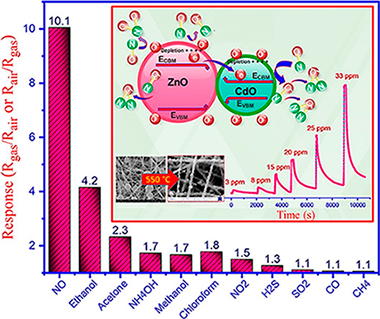
Abstract
Electrospinning method followed by calcination is applied to synthesize ZnO/CdO nanofibers. Characterization is performed by X-ray diffraction (XRD), scanning electron microscopy (SEM), field emission scanning electron microscopy (FESEM), energy dispersive spectroscopy (EDS), diffuse reflectance spectroscopy (DRS), X-ray photoelectron spectroscopy (XPS), ultraviolet photoelectron spectroscopy (UPS) and reflection electron energy loss spectroscopy (REELS), which resulted in detailed analysis of the sensing material. For instance, it was found that the ZnO/CdO is n-n type I heterojunction which possesses straddling energy band gap, which could affect the mechanism of gas sensing. An electroless gold-plated interdigitated electrode with spacing 200 mu m is fabricated on alumina substrate to host the designed nanofibers being used as gas sensor. Gas-sensing activity of the heterojunction is investigated against NO, NO2, H2S, CH4, SO2 and CO in addition to VOCs such as ethanol, acetone, ammonia, methanol, and chloroform with high selectivity and response to NO gas by monitoring resistance changes. Detailed discussion on the mechanism of sensing is presented. The ZnO/CdO nanofibers are found to be highly sensitive to very low concentration range of NO gas (1.2-33 ppm) at optimal operating temperature of 215 degrees C. The influence of humidity (20-96%) on the sensor response was found to be ignorable. Additionally, good repeatability and long-term stability (45 days, every 5 days, SD = 0.7) was obtained for this sensor. Typically, short response times of 47 and 35 s are obtained versus 3 and 33 ppm of NO, respectively, making our sensor promisingly applicable for monitoring this toxic gas in polluting industries, metropolises and maybe in exhaled breath.
October, 2019 · DOI: 10.1016/j.snb.2019.126774
Fotocatálisis Heterogénea: Aplicaciones
Comparison of the effects generated by the dry-soft grinding and the photodeposition of Au and Pt processes on the visible light absorption and photoactivity of TiO2
Galeano, L; Valencia, S; Marin, JM; Restrepo, G; Navio, JA; Hidalgo, MCMaterials Research Express, 6 (2019) 1050d9 DOI: 10.1088/2053-1591/ab4316
Abstract
The influence of dry-soft grinding and photodeposition of gold (Au) or platinum (Pt) in the improvement of the photoactivity of TiO2 synthesized by an integrated sol-gel and solvothermal method was studied. TiO2 was modified by a dry-soft grinding process in a planetary ball mill (TiO2(G)). Subsequently, Au or Pt particles were photodeposited in both unmodified TiO2 and TiO2(G) obtaining Au-TiO2, Pt-TiO2, Au-TiO2(G), and Pt-TiO2(G) materials. The photoactivity of the materials was evaluated in the phenol photodegradation under simulated solar radiation. Pt-TiO2 showed the greatest degree of photoactivity improvement in comparison with TiO2 and TiO2-P25. The dry-soft grinding process led to a high photocatalytic activity of TiO2(G) that was similar to Pt-TiO2 activity as consequence of a slight increase in the crystallinity in TiO2(G) due to an additional anatase formation in comparison with TiO2. However, further photocatalytic improvement in TiO2(G) were not achieved with the addition of Au or Pt. Therefore, the dry-soft grinding treatment and noble metal deposition led to similar improvements in the photocatalytic activity of TiO2 for phenol oxidation.
October, 2019 · DOI: 10.1088/2053-1591/ab4316
Materiales Coloidales
From structure to luminescence investigation of oxyfluoride transparent glasses and glass-ceramics doped with Eu3+/Dy3+ ions
Walas, M; Lisowska, M; Lewandowski, T; Becerro, AI; Lapinski, M; Synak, A; Sadowski, W; Koscielska, BJournal of Alloys and Compounds, 896 (2019) 1410-1418 DOI: 10.1016/j.jallcom.2019.07.017

Abstract
Glasses and glass-ceramics with nominal composition 73 TeO2- 4BaO-3Bi(2)O(3)-18SrF(2)-2RE(2)O(3) (where RE = Eu, Dy) have been synthesized by conventional melt-quenching technique and subsequent heat treatment at 370 degrees C for 24 h in air atmosphere. Various Eu3+ to Dy3+ molar ratio have been applied to investigate luminescence properties in both glass and glass-ceramic matrices. Especially, white light emission through simultaneous excitation of Eu3+ and Dy3+ has been studied in detail. Influence of crystalline SrF2 phase on luminescence kinetics has been determined by luminescence decay time measurements. Presence of crystalline SrF2 phase has been confirmed by X-ray diffraction technique XRD and transmission electron microscopy TEM. X-ray photoelectron spectroscopy XPS and Fourier-transform infrared spectroscopy FTIR have been applied to get further insight into structural properties of glass and glass-ceramic materials. Color tunable white light emission has been obtained using UV excitation. Influence of the SrF2 crystallization on luminescence properties of prepared materials have been described in detail. Moreover, luminescence properties and especially emission color dependence on the Eu3+ to Dy3+ molar ratio have been exhaustively studied. Color-tunable white light emission has been observed as a result of simultaneous radiative transition of both, Eu3+ and Dy3+ ions when applying UV excitation. Judd - Ofelt and other optical parameters have been calculated based on luminescence emission spectra. Achieved results confirm that tellurite glass-ceramics containing SrF2 nanocrystals are good hosts for RE3+ ions and they can be considered as new phosphors for white light emitting diodes WLEDs.
October, 2019 · DOI: 10.1016/j.jallcom.2019.07.017
Materiales Ópticos Multifuncionales
Casimir-Lifshitz Force Based Optical Resonators
Esteso, V; Carretero-Palacios, S; Miguez, HJournal of Physical Chemistry Letters, 10 (2019) 5856-5860 DOI: 10.1021/acs.jpclett.9b02030
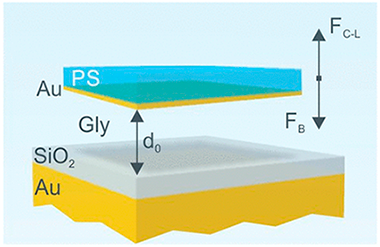
Abstract
We theoretically investigate the building of optical resonators based on the levitation properties of thin films subjected to strong repulsive Casimir-Lifshitz forces when immersed in an adequate medium and confronted with a planar substrate. We propose a design in which cavities supporting high Q-factor optical modes at visible frequencies can be achieved by means of combining commonly found materials, such as silicon oxide, polystyrene or gold, with glycerol as a mediating medium. We use the balance between flotation and repulsive Casimir-Lifshitz forces in the system to accurately tune the optical cavity thickness and hence its modes. The effects of other forces, such as electrostatic, that may come into play are also considered. Our results constitute a proof of concept that may open the route to the design of photonic architectures in environments in which dispersion forces play a substantial role and could be of particular relevance for devising novel microfluidic optical resonators.
October, 2019 · DOI: 10.1021/acs.jpclett.9b02030
Reactividad de Sólidos
A QTAIM and DFT study of the dizinc bond in non-symmetric [CpZn2Ln] complexes
Ayala, R; Galindo, AJournal of Organometallic Chemistry, 898 (2019) UNSP 120878 DOI: 10.1016/j.jorganchem.2019.120878
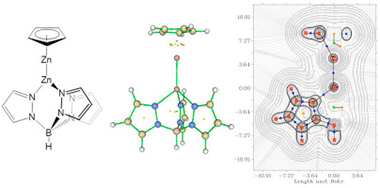
Abstract
Several [Zn2L2] and [CpZn2Ln] dizinc compounds have been studied by density functional theory (DFT) and quantum theory of atoms in molecules (QTAIM) in order to compare the nature and topology of the Zn-Zn bond in symmetrical and non-symmetrical complexes. The stability of these complexes have been evaluated on the basis of the formation energies. The disproportionation reaction has also been analysed indicating that symmetric complexes are less stable than non-symmetric ones. To certain extent, the properties of the [CpZn2Ln] complexes are between those of the [Zn2L2] and [Zn2Cp2] compounds. The asymmetry of the [CpZn2Ln] compounds is illustrated in terms of the topological properties, especially in the Source Function (SF) and Natural Bond Orbital (NBO) analysis.
October, 2019 · DOI: 10.1016/j.jorganchem.2019.120878
Reactividad de Sólidos
Influence of pre-deformation on the precipitation hardening in Cu-Ni-Si alloy
Donoso, E; Dianez, MJ; Criado, JMRevista de Metalurgia, 55 (2019) e157 DOI: 10.3989/revmetalm.157
Abstract
The effects of pre-deformation on the precipitation processes in a Cu-2.8 Ni-1.4 Si (at.%) alloy were studied using differential scanning calorimetric (DSC), transmission electron microscopy (TEM) and microhardness measurements. The calorimetric curves shows the presence of one exothermic reaction attributed to the formation of delta-Ni2Si precipitates in the copper matrix that was confirmed by TEM. In addition it can be observed that the temperature of the maximum of the DSC peak decreases with the increase of the pre-deformation to the aging treatments. The activation energies calculated for the precipitation of by the Kissinger method, were similar to those calculated by an Arrhenius function, from the maximum hardening of the matrix due to aging treatments (saturation of the hardness during isothermal aging). The analysis of the microhardness measurements together with the calorimetric curves and the TEM micrographs confirm, on the one hand, that the formation of the delta-Ni2Si phase, during the aging treatments, are responsible for the hardening of the copper matrix, and on the other hand that the deformation prior to the aging treatment partially inhibits the formation of the precipitates.
October, 2019 · DOI: 10.3989/revmetalm.157
Materiales Ópticos Multifuncionales
Spatially Resolved Analysis of Defect Annihilation and Recovery Dynamics in Metal Halide Perovskite Single Crystals
Galisteo-Lopez, JF; Calvo, ME; Miguez, HACS Applied Energy Materials, 2 (2019) 6967-6972 DOI: 10.1021/acsaem.9b01335
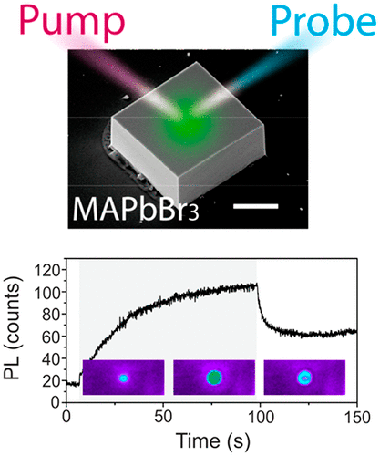
Abstract
The spectacular advances in efficiency of optoelectronic devices based on lead-halide perovskites have been accompanied by detailed structural and optical studies regarding the instability presented by these materials, which constitute their main bottleneck for commercialization. Following a pump and probe scheme in a laser scanning confocal microscope, we resolve the photoinduced emission activation/deactivation dynamics in CH3NH3PbBr3 single crystals with millisecond and sub-micrometer resolution. This is complemented with a study of spectral variations and interpreted in the framework of light-induced ion migration and associated defect passivation. Our results point to the presence of photoinduced structural changes accompanying the migration of ions.
October, 2019 · DOI: 10.1021/acsaem.9b01335
Nanotecnología en Superficies y Plasma
Sodium ion storage performance of magnetron sputtered WO3 thin films
Garcia-Garcia, FJ; Mosa, J; Gonzalez-Elipe, AR; Aparicio, MElectrochimica Acta, 321 (2019) 134669 DOI: 10.1016/j.electacta.2019.134669
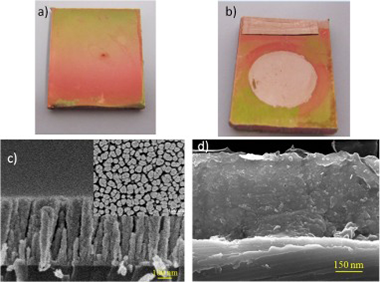
Abstract
WO3 thin film electrodes were successfully prepared by magnetron sputtering (MS) deposition under an oblique angle configuration (OAD). Intercalation of Na ions in the tungsten oxide layers has been studied using electrochemical techniques. Sample characterization before and after sodium intercalation has been carried out by Raman, XPS and XRD measurements. ToF-SIMS analysis has been also performed in order to analyze the element depth profiles along the electrode thickness. Electron microscopy evaluation of the cross section confirms the porous structure of the coatings. Batteries integrating these WO3 electrodes have a discharge capacity of 120 mA h g(-1) at the initial cycles and show an adequate capacity retention upon 300 cycles. The WO3-OAD thin-films are proposed as promising electrodes for Na-ion batteries.
October, 2019 · DOI: 10.1016/j.electacta.2019.134669
Nanotecnología en Superficies y Plasma
SiOx by magnetron sputtered revisited: Tailoring the photonic properties of multilayers
Garcia-Valenzuela, A; Alvarez, R; Espinos, JP; Rico, V; Gil-Rostra, J; Palmero, A; Gonzalez-Elipe, ARApplied Surface Science, 488 (2019) 791-800 DOI: 10.1016/j.apsusc.2019.05.273

Abstract
Traditionally porous silicon based photonic structures have been prepared by electrochemically etching of silicon. In this work, porous multilayers of nanocolumnar SiOx and SiO2 thin films acting as near infrared (NIR) 1D-photonic nanostructures are prepared by magnetron sputtering deposition at oblique angles (MS-OA). Simultaneous control of porosity and stoichiometry of the stacked films is achieved by adjusting the deposition angle and oxygen partial pressure according to a parametric formula. This new methodologoy is proved for the synthesis of SiOx thin films with x close to 0.4, 0.8, 1.2, 1.6 and nanostructures varying from compact (at 0 degrees deposition angle) to highly porous and nanocolumnar (at 70 degrees and 85 degrees deposition angles). The strict control of composition, structure and nanostructure provided by this technique permits a fine tuning of the absorption edge and refraction index at 1500 nm of the porous films and their manufacturing in the form of SiOx-SiO2 porous multilayers acting as near infrared (NIR) 1D-photonic structures with well-defined optofluidic responses. Liquid tunable NIR Bragg mirrors and Bragg microcavities for liquid sensing applications are presented as proof of concept of the possibilities of this MS-OA manufacturing method as an alternative to the conventional electrochemical fabrication of silicon based photonic structures.
September, 2019 · DOI: 10.1016/j.apsusc.2019.05.273
Fotocatálisis Heterogénea: Aplicaciones
Extraordinary visible photocatalytic activity of a Co0.2Zn0.8O system studied in the Remazol BB oxidation
KarimTanji; J.A.Navio; Jamal Naja; M.C.Hidalgo; Abdellah Chaqroune; C.Jaramillo-Páez; Abdelhak KherbecheJournal of Photochemistry and Photobiology A: Chemistry, 382 (2019) 111877 DOI: 10.1016/j.jphotochem.2019.111877

Abstract
Nanoparticles of CoxZn1-xO system with a nominal composition of x=0.2 were synthesized by the Solution Combustion Method (SCM). Structural and morphological studies as well as the chemical composition of the material were widely investigated by different techniques. Photocatalytic activity under UV and Visible illumination was studied by means of the Remazol Brilliant Blue dye (RBB) oxidation reaction. The effect of different experimental parameters, such as the initial dye concentration, photocatalyst mass, pH or hydrogen peroxide concentration on the RBB discoloration under UV irradiation was studied. Optimal experimental conditions were found to be a photocatalyst mass of 1 g.L-1, dye concentration of 20 mg.L-1 and solution pH of 11. Hydrogen peroxide addition was found to have no effect in the photocatalytic behavior of the material in the range of concentration studied (0 to 6•10-4 M). The optimal parameters were chosen to investigate the degradation of RBB under UV-illumination and just visible illumination. It was observed that the UV-photocatalytic property of pristine ZnO for the RBB removal was scarcely improved after cobalt-incorporation, whereas the effect of cobalt incorporation into ZnO greatly enhanced the RBB conversion under visible illumination. Even more interesting is that, under same experimental conditions, the visible efficiency of the Co-ZnO system is the same that the one showed under UV illumination, i.e. the system does not loose efficiency when illuminated only with visible light.
September, 2019 · DOI: 10.1016/j.jphotochem.2019.111877
2018
2018
Propiedades mecánicas, modelización y caracterización de cerámicos avanzados
Elusive super-hard B6C accessible through the laser-floating zone method
Moshtaghioun, BM; Cumbrera, FL; Gomez-Garcia, D; Pena, JIScientific Reports, 9 (2019) art. 13340 DOI: 10.1038/s41598-019-49985-2
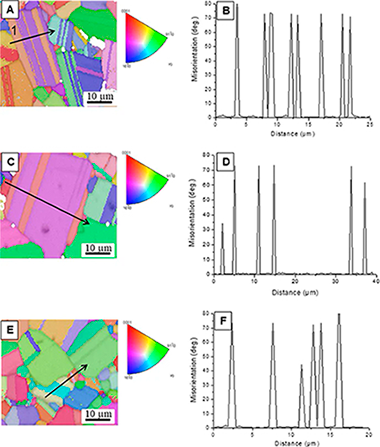
Abstract
Boron carbide is among the most promising ceramic materials nowadays: their mechanical properties are outstanding, and they open potential critical applications in near future. Since sinterability is the most critical drawback to this goal, innovative and competitive sintering procedures are attractive research topics in the science and technology of this carbide. This work reports the pioneer use of the laser-floating zone technique with this carbide. Crystallographic, microstructural and mechanical characterization of the so-prepared samples is carefully analysed. One unexpected output is the fabrication of a B6C composite when critical conditions of growth rate are adopted. Since this is one of the hardest materials in Nature and it is achievable only under extremely high pressures and temperatures in hot-pressing, the use of this technique offers a promising alternative for the fabrication. Hardness and elastic modulus of this material reached to 52 GPa and 600 GPa respectively, which is close to theoretical predictions reported in literature.
September, 2019 · DOI: 10.1038/s41598-019-49985-2
- ‹ previous
- 12 of 37
- next ›














